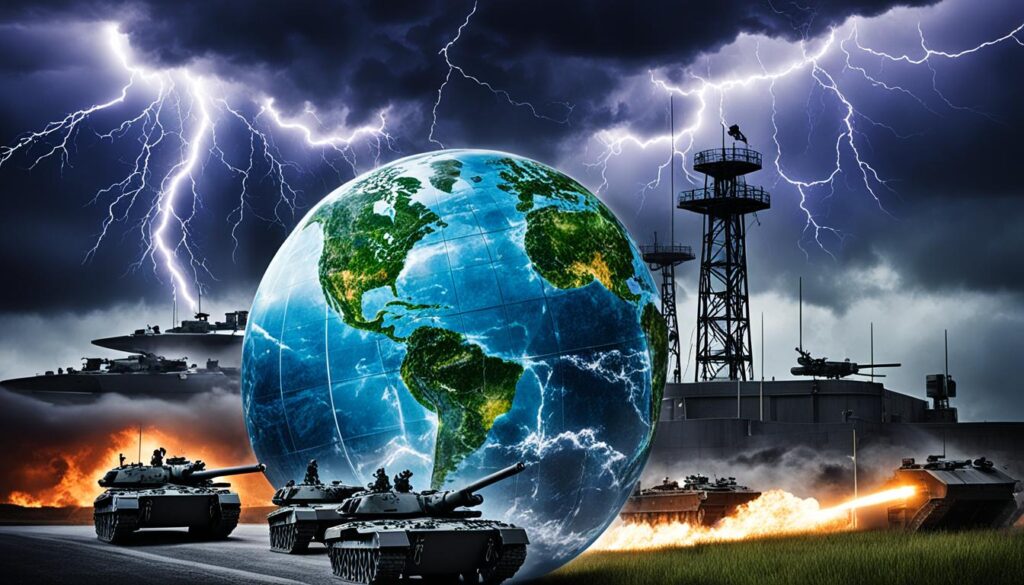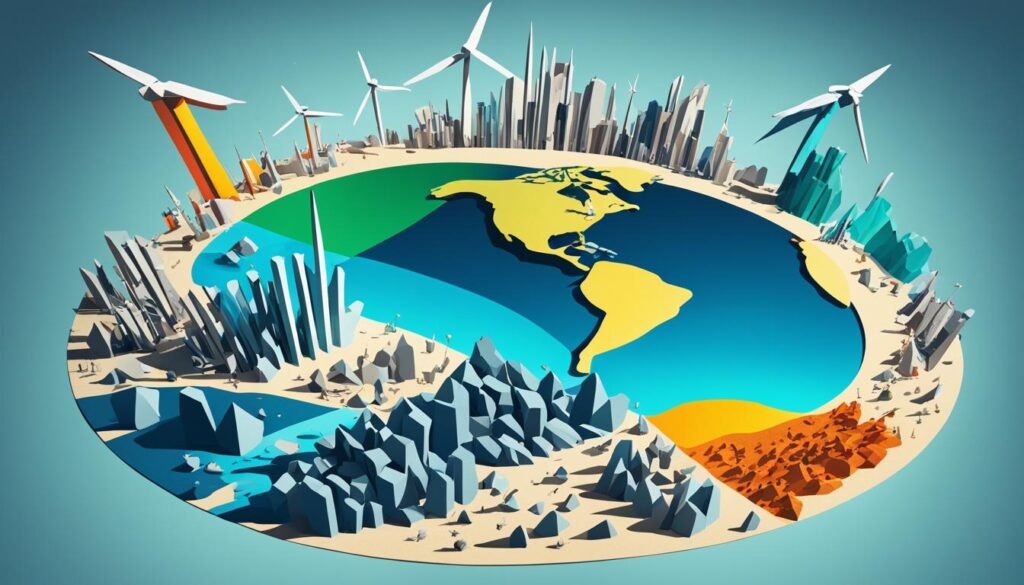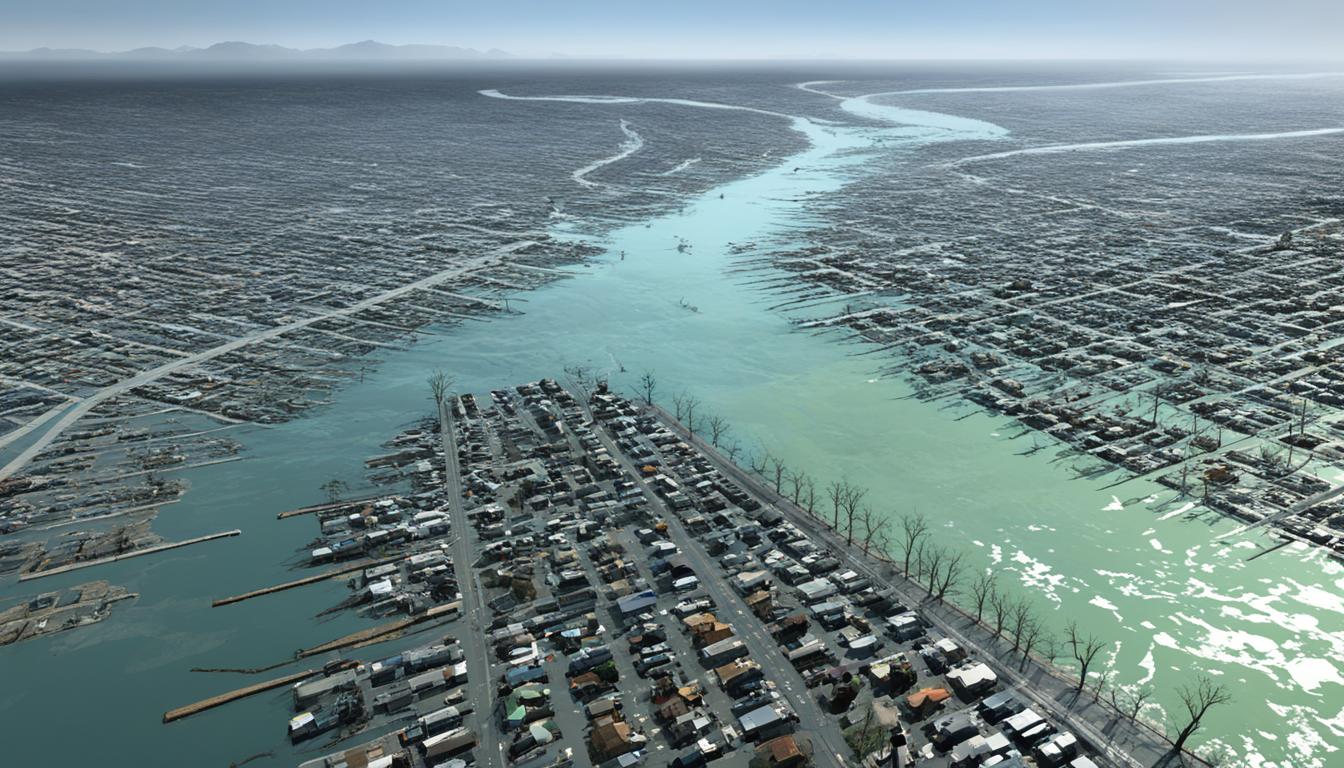Climate change is changing our world in many ways, from nature to human activities. The National Intelligence Council says it will make risks to U.S. national security worse. This is because of the physical effects and tensions over how to deal with it1. The U.S. Defense Department sees climate change as a “threat multiplier.” It makes existing environmental and security problems worse2. This article will look at how climate change threatens national security directly and indirectly.
Key Takeaways
- Many federal agencies see climate change as a big threat to national security.
- Climate change is already affecting security and emergency plans with things like more Arctic shipping and extreme weather.
- Places that are already struggling are more likely to face big problems because of climate change.
- The military is now planning for climate change to handle security risks.
- Climate change can lead to humanitarian crises around the world, putting a strain on military resources.
Introduction to Climate Change and Security Risks
In recent years, the climate change security linkages have become more important. As climate change speeds up, it makes existing social, economic, and environmental problems worse. This can lead to more insecurity at local and international levels. Climate-security nexus concerns include issues with food, water, and energy, more fights over natural resources, loss of jobs, climate disasters, and people moving because of climate change3.
Even though more people know about the link between climate change impacts on national security, there aren’t many programs that tackle these issues together4.
The Growing Recognition of Climate Change as a Security Threat
The U.S. intelligence community has warned about climate change as a global threat for years3. Many military experts see climate change as a big national security issue3. Now, many government and private groups agree that climate change and security risks are closely linked3.
The Impacts of Climate Change on Security at Various Levels
The latest report from the Intergovernmental Panel on Climate Change (August 2021) says the world faces huge risks from climate change, affecting every area4. Droughts led to the Syrian civil war in 20113. Rising seas could cause big refugee crises in Southeast Asia3. Melting sea ice in the Arctic might lead to new tensions among countries at the top of the world3.
Experts call climate change a “threat multiplier” that makes things unstable and can cause conflict. It can make people fight over resources and increase ethnic tensions3. The U.S. Intelligence Community says environmental damage and climate change will make people fight over resources and cause economic and social problems3.
Extreme weather events from sea-level rise will hit areas like South Asia, Southeast Asia, and the Western Hemisphere hard3. Climate change making water and food scarce is raising the chance of conflict in places like Egypt, Ethiopia, Iraq, and Jordan3.
Most special missions by the Department of Political and Peacebuilding Affairs are in very climate-vulnerable countries4. The UN Assistance Mission in Somalia is the first UN mission to focus on climate-related security risks4.
“Climate change is making it hard for the military to train and test, with more events being canceled or delayed, especially in the U.S. Southeast and Southwest.”3
The Climate Security Mechanism (CSM) helps the UN deal with climate-related security risks better4. The UN Community of Practice on Climate Security has over 500 people from 25 UN groups sharing information and creating new knowledge4.
Direct Threats of Climate Change to National Security
Climate change is a big threat to national security. It affects military bases and supply lines56. Rising temperatures and high carbon dioxide levels are causing problems for the U.S. military5.
Impact on Military Infrastructure and Supply Chains
Many military bases are near the coast and face threats from sea-level rise and extreme weather6. These threats damage military bases, like Fort Irwin in California, and disrupt operations6. Climate disasters also make it hard to get the supplies the military needs6.
Increased Demand for Military Resources in Disaster Relief
Natural disasters are happening more often, making the military a key player in relief efforts67. They are handling more emergencies, from wildfires to floods, which strains their resources7. This shows how big a challenge climate change is for national security7.
“Climate change can act as a threat multiplier for instability in volatile regions of the world.”6
Climate change is a big problem for military bases and supply lines. It also means more work for disaster relief. The U.S. needs to tackle these security risks from climate change67. By getting ready for these threats, the military can stay strong and protect national security657.
Indirect Threats Posed by Climate Change
Climate change’s indirect threats are even bigger worries for global security8. It makes existing security risks worse by affecting things like water, food, and energy8. When these key resources get scarce, it can cause people to move, lead to unrest, and even make states fail8.
Climate-Induced Migration and Civil Unrest
Climate change could lead to huge human migrations9. The World Bank says 143 million people might move due to climate change in South Asia, sub-Saharan Africa, and Latin America9. These migrants could cause tensions in new places, leading to more poverty, inequality, and violence8. This could change the balance of power in regions or cause states to fail, possibly needing U.S. military help to calm things down8.
Climate change affects food, water, health, and basic services, causing unrest and instability8. For instance, less water, food, and energy can lead to protests and conflicts as people fight for their needs8. These issues can spread, threatening security at both local and global levels8.
Coastal areas and small island nations face big risks from climate change8. Sea level rise and extreme weather can destroy economic centers, infrastructure, and military bases, threatening their survival8. This can cause migration and instability that spreads across borders, making security worse8.
Climate change, resource shortages, and migration show we need a strong plan to tackle these risks8. Leaders and military planners must work together to find ways to lessen climate change’s effects on global security8910.
Climate Change and Security Risks: What to Know
Climate change is a big threat to national security. The U.S. Defense Department sees it as a “threat multiplier” that makes things worse11. As climate change gets worse, so does the need for defense operations, making them more expensive11. It also leads to political instability, fights over resources, and tensions between countries, affecting U.S. security11.
Climate change affects security in many ways. Over 20 million people move because of climate change each year, due to extreme weather and rising sea levels11. By 2030, 68 to 135 million people could be pushed into poverty because of climate change11. Women and girls face more security risks, like sexual violence, because of climate change11.
Climate change also harms military bases and supply chains. For example, the Canadian Armed Forces fought fires for over 100 days in 2023 because of climate change12. The U.S. National Guard has been deployed over 70 times in two years to deal with climate issues12. This is why the world is working together, like NATO’s plan to tackle climate change’s effects on security12.
We need a broad approach to deal with climate and security issues. This includes understanding how the military responds to climate hazards, following NATO’s plan, and working on sustainable energy12. With climate change threatening global peace, we must act fast and work together to lessen its effects13.
| Direct Threats of Climate Change to National Security | Indirect Threats Posed by Climate Change |
|---|---|
|
|
“Climate change is considered one of the greatest risks for peace and security in the 21st century.”13

The Great Green Wall in Africa’s Sahel aims to fix 100 million hectares of land, save 250 million tonnes of carbon, and create 10 million jobs by 203011. This shows how we’re trying to tackle climate and security issues together.
Dealing with climate change’s effects on security is key for keeping the world safe and peaceful131112.
Conflicts Surrounding Decarbonization Efforts
The world is racing to fight climate change and move to a low-carbon economy. But, there are growing disagreements about who should pay and how14. Poor countries want rich nations to help fund their climate projects more15. At the same time, countries that depend on fossil fuels are worried about their economies as the energy world changes.
Tensions over Responsibility and Financing
There are big debates over who should take the lead in fighting climate change15. Developing countries say richer nations should give more money for climate action15. This has led to talks and deals, as the promised $100 billion a year for climate aid is still missing16.
Impacts on the Fossil Fuel Economy
Switching to cleaner energy is a big worry for countries that have always used fossil fuels16. Some countries are slowing down on reducing carbon emissions because they fear it could hurt their economies and people16. Finding a way to balance climate change decarbonization conflicts with economic needs is key for a fair transition.
“The impacts of climate change have implications on a global scale and require coordinated collective action.”16
Fixing the climate change decarbonization conflicts needs a careful and team effort16. Everyone must work together to find fair solutions16. By tackling these big challenges, we can move towards a future that’s sustainable and low on carbon141516.
Competition for Critical Resources in the Clean Energy Transition
The world is racing to fight climate change, and the need for key minerals for clean energy is growing fast. Getting these minerals is becoming a big challenge, affecting global power and the success of renewable energy17.
Switching to clean energy needs a lot of minerals like lithium, cobalt, and rare earths. Experts say we might need six times more of these minerals by 2040 to hit net-zero emissions18. This is because electric cars, batteries, and renewable energy use these minerals a lot.
Most of these minerals come from a few countries, especially China, which worries about supply chain issues and price changes19. This has made governments and industries fight for these minerals, leading to more tensions and even conflict risks.
| Country | Critical Minerals Listed |
|---|---|
| United States | 50 |
| European Union | 30 |
| China | 37 |
To deal with this, governments are taking steps. The U.S. has passed laws to boost clean energy, and China plans to stop making internal combustion engine cars by 203519. Groups like the Mineral Security Partnership are also working together for sustainable mining and recycling of these minerals.
The fight for these minerals will get tougher as we move to clean energy. It could affect global security and stability. We need a plan that deals with both reducing carbon and the challenges of getting these minerals17.

“Without swift action on climate change, over 140 million people in sub-Saharan Africa, Latin America, and South Asia will be forced to migrate within national borders by 2050.”17
Dealing with climate change’s security issues, the fight for minerals in clean energy is a big worry. We need everyone to work together for a fair and sustainable way to reduce carbon and handle the challenges of getting these minerals.
The Melting Arctic and Emerging Geopolitical Tensions
The Arctic region is now a key focus in global politics due to climate change. The melting ice is opening up the Northwest Passage, a key shipping route. This is causing nations to compete for access and the region’s resources2021.
The Opening of the Northwest Passage
As Arctic ice melts, the Northwest Passage is becoming a viable shipping route21. By 2035, some areas might be ice-free in summer, making shipping faster21. This has sparked a race among nations to control the region’s waters and resources.
Competition for Arctic Resources and Territorial Claims
Countries are racing for the Arctic’s oil, gas, and minerals as it becomes more accessible20. Without a global shift to clean energy, the Arctic could be ice-free, filled with ships and drilling rigs20. This has raised tensions, with Russia and China making their moves in the region.
Russia is upgrading its military bases and claiming the Northern Sea Route as its own21. Canada says the Northwest Passage is its waters, but the U.S. and Europe disagree, seeing it as an international strait21. These disputes could lead to conflicts in the Arctic.
The Biden administration sees national security as crucial in the Arctic, due to Russia’s military and China’s growing influence21. The U.S. is watching Russia and China closely, especially after their military exercises near Alaska21.
The Arctic’s complex politics are also about protecting the environment and balancing commercial interests202122. As the competition grows, the need for international cooperation to manage the Arctic’s changes is clear202122.
“The Arctic is the bellwether for global climate change, and what happens in the Arctic doesn’t stay in the Arctic. The dramatic changes we’re seeing in the region have profound implications for the rest of the world.”
– Sherri Goodman, Former U.S. Deputy Undersecretary of Defense for Environmental Security
Efforts to Assess and Address Climate-Related Security Risks
The United Nations Environment Programme (UNEP) leads the world in linking climate change with security. In 2009, it teamed up with groups like the International Organization for Migration (IOM) and the United Nations University (UNU) to study climate change’s effects on the Sahel region23.
UNEP’s Work on Climate Change and Security
UNEP helps countries prepare for climate-related security risks through assessments and training24. It uses tools like the Strata data platform to spot and track environmental and climate issues that could lead to security threats24.
National and International Initiatives
The Biden-Harris Administration sees fighting the climate crisis as key to national and foreign policy23. They’ve launched the National Intelligence Estimate on Climate Change and the Department of Defense Climate Risk Analysis23. The Department of Homeland Security also has a plan to adapt to climate risks23.
The European Union and UNEP teamed up in 2017 to tackle climate change and security24. Their five-year project helped countries and partners spot and deal with security risks from climate change24. The project worked in Nepal and Sudan, offering tools for adapting to climate change and building sustainable lives24.
The OSCE and adelphi are working on a project to lower climate change security risks in South-Eastern Europe and other regions25. They aim to increase awareness, build skills, and share knowledge to tackle these risks25.
These efforts show how climate change is seen as a big security threat. They highlight global actions to understand, tackle, and build resilience against climate-related security risks23. Scientists say human actions cause climate change and its severe effects on life and security23. The Biden Administration has released studies on climate and security risks to guide decisions with science23.
“Climate change is reshaping the security landscape, with far-reaching implications for U.S. interests and strategic priorities. Addressing the climate crisis must be a core element of U.S. national security and foreign policy.”
– The Biden-Harris Administration
Preparing for Climate-Related Security Challenges
Climate change is a big threat to national security. To fight this, we’re boosting our resilience and adapting to the changes. This means upgrading our infrastructure, making our military gear and tactics better for the new climate, and getting better at handling disasters26.
Enhancing Resilience and Adaptation Measures
NATO has been leading the fight against environmental security since the 1960s. They started the Committee on the Challenges of Modern Society in 1969 to deal with pollution, healthcare, and waste disposal26. Over time, NATO’s efforts grew, merging the Science Committee with the CCMS in 2006. Now, the Science for Peace and Security Programme tackles many security issues, including environmental security and natural disaster prevention26.
Recently, NATO has made big moves to include climate change in its plans. In 2021, they adopted a Climate Change and Security Action Plan. The 2022 NATO Strategic Concept sees climate change as a major security threat. They’re setting up a NATO Centre of Excellence for Climate Change and Security in Montreal, Canada26.
Strengthening International Cooperation and Governance
We also need to work together on a global scale to tackle climate-related security risks. This means sharing data, mixing climate and security in policy, and making plans to build resilience against climate change26.
NATO has been working with other countries on environmental security since the 1990s. They’re a top priority for partners, who want NATO’s help in these efforts26. NATO’s Trust Funds started in 2000 to help countries demilitarize and build capacity, following high environmental standards26. The Euro-Atlantic Disaster Response Coordination Centre has been helping with disaster response since the late 1990s26.
The United States is also teaming up with countries like Madagascar, Palau, Peru, and Ecuador to improve climate resilience27. These partnerships aim to strengthen security, boost awareness, and get better at handling climate disasters27.
The United Nations is also key in linking climate change to security. The Security Council first looked at these links in 2007, and in 2017, they passed a resolution on climate-related risks in the Lake Chad basin28. The UNDP has worked on hundreds of projects in over 140 countries to address climate-security issues. A recent Security Council debate brought together over 70 Member States28.
Dealing with climate-related security challenges needs a big, joined-up effort. This means working together, using data in policy, and focusing on building resilience. As climate change keeps changing, we must all work together to keep the world safe and stable262728.
“Climate change is a threat multiplier, exacerbating existing tensions and instability. Addressing its security implications requires a coordinated global effort.” – Lindsay Getschel, UN Youth Representative28
| Country | Exclusive Economic Zone (EEZ) Size | Climate Change Impacts | U.S. Collaboration |
|---|---|---|---|
| Madagascar | 473,075 square miles (1,225,259 square kilometers)27 | – | Enhancing security sector governance27 |
| Palau | 230,197 square miles (596,208 square kilometers)27 | – | Enhancing security sector governance27 |
| Peru | – | Increased flooding, droughts, stronger El Niño effect27 | Implementing emergency response strategy, developing programs for military first responders27 |
| Ecuador | – | Increased flooding, droughts, stronger El Niño effect27 | Developing robust multi-domain awareness to monitor and respond to climate-related events27 |
Conclusion
Climate change is a big threat to national security, with many direct and indirect effects29. A rise in sea level by just half a meter could threaten the survival of many Pacific Island nations29. This could lead to fights over resources and even war29. Climate change affects the core of security issues29.
The economic damage from climate change could seriously harm America’s security, as warned in the 2006 Stern Review29. Climate change is now seen as a major security concern29.
30 The CNA Corporation’s Military Advisory Board, with 11 retired U.S. generals and admirals, sees climate change as a big threat to America’s security30. They found four key points on climate change and security, and suggested five ways to tackle it30. The UN Security Council talked about climate change and its effects on security for the first time in April30. The world’s population is expected to hit 9.5 billion by 2050, with most growth in Asia and Africa30.
31 The UN’s IPCC says global warming will cause more heat, rain, sea rise, extreme weather, and changes in disease and seasons31. From 1990 to 1999, 188 million people faced natural disasters each year, six times more than those affected by war31. A study suggests global warming may cause up to 160,000 deaths a year from diseases and hunger, with this number possibly doubling by 202031. The UN wants nations to agree on cutting emissions and helping vulnerable countries adapt, but doubts exist about how well this will address climate change’s security risks31.
FAQ
What is the relationship between climate change and national security?
How does climate change affect military operations and capabilities?
What are the indirect security threats posed by climate change?
How is the global competition for critical resources affected by the clean energy transition?
What are the security implications of the melting Arctic ice?
How are international organizations and governments addressing climate-related security risks?
Source Links
- DoD Releases Report on Security Implications of Climate Change
- National Security and Climate Change: What Do We Need to Know?
- A brief introduction to climate change and national security » Yale Climate Connections
- Addressing the Impact of Climate Change on Peace and Security
- GPG3474_CoverFinal.indd
- Climate Change Impacts on National Security
- Is climate change a security risk?
- Why Climate Change Is a National Security Risk
- Climate change and security risks
- Five ways the climate crisis impacts human security | United Nations
- The Center for Climate & Security
- Climate Change, Peace and Security: Understanding Climate-Related Security Risks Through an Integrated Lens
- With Climate Crisis Generating Growing Threats to Global Peace, Security Council Must Ramp Up Efforts, Lessen Risk of Conflicts, Speakers Stress in Open Debate
- Global Climate Agreements: Successes and Failures
- Secretary-General’s remarks to the Security Council – on addressing climate-related security risks to international peace and security through mitigation and resilience building [bilingual as delivered, scroll down for all-english]
- Massive Displacement, Greater Competition for Scarce Resources Cited as Major Risks in Security Council Debate on Climate-Related Threats
- Executive summary – The Role of Critical Minerals in Clean Energy Transitions – Analysis – IEA
- The Changing Geopolitics of Critical Minerals and the Future of the Clean Energy Transition
- Melting Arctic to Open Up New Trade Routes and Geopolitical Flashpoints
- The geopolitics of a changing Arctic
- Fact Sheet: Prioritizing Climate in Foreign Policy and National Security | The White House
- Addressing Climate-Related Security Risks
- Strengthening Responses to Security Risks from Climate Change in South-Eastern Europe, Eastern Europe, the South Caucasus and Central Asia
- Environment, climate change and security
- Strengthening Climate Security Through Enhanced Security Sector Governance – United States Department of State
- Climate change recognized as ‘threat multiplier’, UN Security Council debates its impact on peace
- The Greatest Threat To Global Security: Climate Change Is Not Merely An Environmental Problem | United Nations
- National Security and the Threat of Climate Change
- Microsoft Word – Purvis Busby.doc

